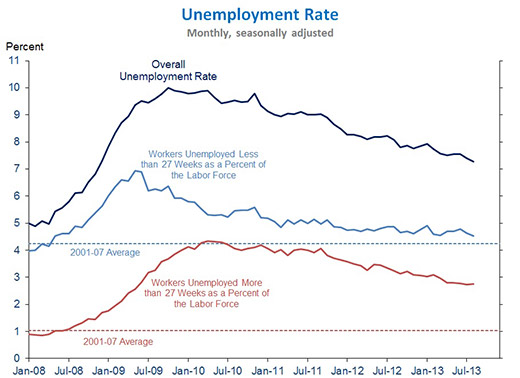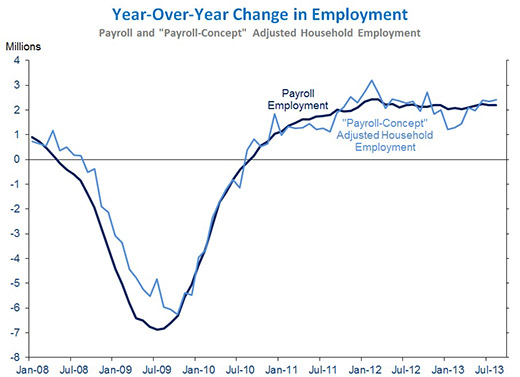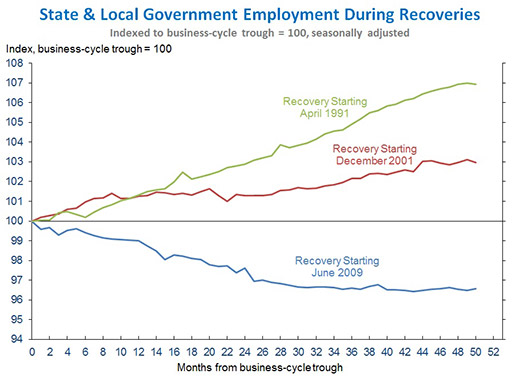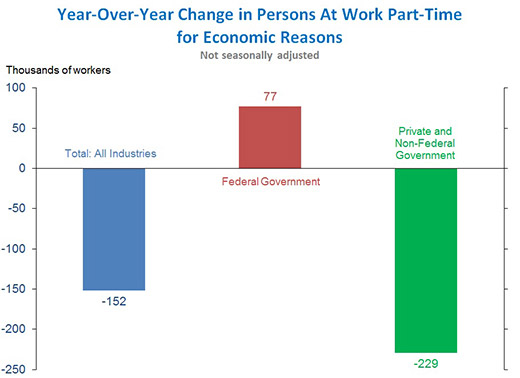
Over the last four years, we’ve cleared away the rubble from the financial crisis and begun to lay a new foundation for stronger, more durable economic growth. With continued solid job gains, today’s employment report is another sign of progress, but we must continue to pursue policies that move our economy forward and restore middle class security.
Five Key Points in Today’s Report from the Bureau of Labor Statistics
1. Private sector employment has risen for 42 consecutive months, with businesses adding a total of 7.5 million jobs over that period. Today we learned that total non-farm payroll employment rose by 169,000 in August, with the private sector accounting for 152,000 of that gain. Private sector job growth was revised down for June (to 194,000) and July (to 127,000), so that over the past three months, private sector employment has risen by an average of 158,000 per month. The monthly change is shown below.

2. The overall unemployment rate ticked down 0.1 percentage point to 7.3 percent, the lowest since December 2008, with long-term unemployment remaining elevated. Although the unemployment rate remains too high, it has been trending down steadily since late 2009. The lingering elevation in the unemployment rate primarily reflects a large number of long-term unemployed (those unemployed for more than 27 weeks), while the share of the labor force that has been unemployed for less than 27 weeks has mostly returned to its average during the 2001-07 expansion period. That's why the administration continues to push for measures to spur job creation now and put the long term unemployed back to work.

3. The economy has been consistently adding jobs at a pace of more than 2 million per year. Over the twelve months ending August 2013, total non-farm payroll employment rose by 2.2 million, similar to the gain in the year-earlier period. While the month-to-month figures can be volatile, the year-over-year changes indicate that the recovery has been durable in the face of several headwinds that have emerged in recent years. The separate household survey is more volatile month-to-month, but over a longer period, it tells the same story. When adjusted by the Bureau of Labor Statistics to be comparable to the concept of employment used in the payroll measure, household employment has risen by 2.4 million over the twelve months ending August 2013.

4. CEA estimates that if state and local government employment had held steady during the recovery, the unemployment rate would currently be below 7 percent. Unlike previous recoveries in which state and local government employment- like teachers, fire fighters and first responders-- expanded, public payrolls have declined in the current recovery (see chart). During the current 42-month consecutive streak of increasing private sector employment, state and local government employment has fallen by 507,000, including the loss of 267,000 education positions.

5. The number of persons working part-time for involuntary “economic reasons” has fallen by 152,000 over the past twelve months. Budget cuts due to sequestration led to an increase of 77,000 in the number of federal government employees at work part-time for economic reasons, so the number of persons part-time for economic reasons in private sector and non-federal government positions is down by an even larger 229,000 (see chart, based on not seasonally adjusted data). Measures of part-time employment can be volatile month-to-month, but the seasonally-adjusted 334,000 drop in persons working part-time for economic reasons in August almost entirely reversed the increase over the preceding two months.

As the Administration stresses every month, the monthly employment and unemployment figures can be volatile, and payroll employment estimates can be subject to substantial revision. Therefore, it is important not to read too much into any one monthly report and it is informative to consider each report in the context of other data that are becoming available. Nevertheless, incoming economic data broadly suggest that the recovery continues to make progress. It is therefore essential that policymakers avoid “self-inflicted wounds” that could derail the recovery and stay focused on policies that will help sustain and boost the pace of job creation.
Jason Furman is Chairman of the Council of Economic Advisers.


